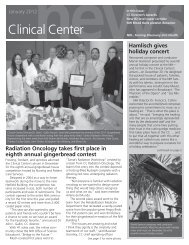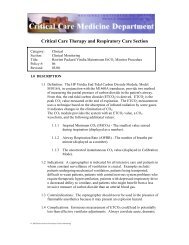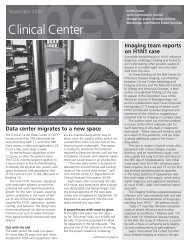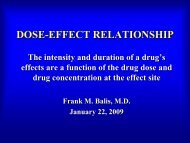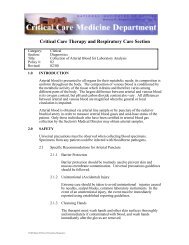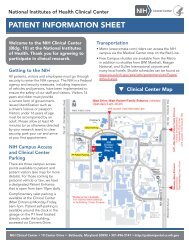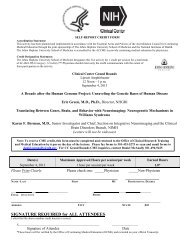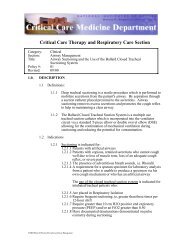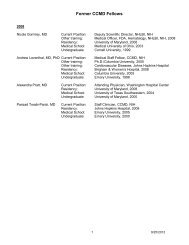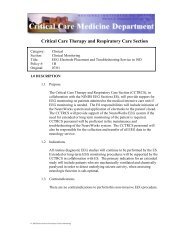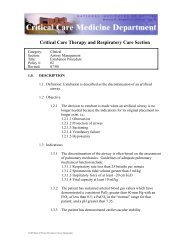2011 - NIH Clinical Center - National Institutes of Health
2011 - NIH Clinical Center - National Institutes of Health
2011 - NIH Clinical Center - National Institutes of Health
Create successful ePaper yourself
Turn your PDF publications into a flip-book with our unique Google optimized e-Paper software.
Rehabilitation Medicine Department’s <strong>Clinical</strong>Movement Analysis Laboratory.“I thought it wasreally interesting,” she said.“They demonstrated thedifferent technologies and showed us the clinicalcorrelates.”The keynote speaker <strong>of</strong> the forum—<strong>NIH</strong>Director Collins—addressed the importance <strong>of</strong>translating basic science discoveries into new andbetter treatments and how the <strong>NIH</strong> is putting scienceto work for the benefit for health care reform.Collins also discussed what the <strong>NIH</strong>is doing to encourage innovation and empoweryoung researchers like CIST Forum attendees.“As the director <strong>of</strong> the <strong>NIH</strong>, one <strong>of</strong> the thingsthat I enjoy most is the opportunity to brainstorm,particularly with people that are going to lead ourfield in the future, and that is all <strong>of</strong> you, about thedirections that science is taking that are going to beparticularly transformative,” he said.Collins closed his speech with a musicalperformance on his double helix-inlayed guitar:a self-penned update about DNA to the tune <strong>of</strong>Del Shannon’s 1960’s hit “Runaway.”“Dr. Collins was amazing. He’s like the superman<strong>of</strong> scientists,” said CRTP fellow Hari Trivedifrom the Medical College <strong>of</strong> Georgia.Above all,for many <strong>of</strong> the forum attendees, though, was thechance to walk away with new contacts.“These are going to be my future colleagues, futurecollaborators, and people who I’ll be seeing overand over again. So getting to know them now,at this early stage, is going to be beneficial forfostering those relationships,” said Shah Ali <strong>of</strong> theStanford University School <strong>of</strong> Medicine, a HowardHughes Medical Institute fellow.<strong>NIH</strong> Director Dr. Francis S.Collins serenaded CIST Forumattendees with a personalizedversion <strong>of</strong> “Runaway” after hiskeynote speech.Former CRTP fellow reflects on influence <strong>of</strong> programThe <strong>NIH</strong> <strong>Clinical</strong> Research Training Program(CRTP) aims to prepare the next generation <strong>of</strong>clinician-scientists through a year <strong>of</strong> immersionin the <strong>NIH</strong> intramural program. One alumna <strong>of</strong>the program recently returned to speak on herexperience and to inspire her successors.Karen H<strong>of</strong>fman, assistant pr<strong>of</strong>essaor in the Department<strong>of</strong> Radiation Oncology at The University<strong>of</strong> Texas MD Anderson Cancer <strong>Center</strong>, spokeon a panel <strong>of</strong> graduates <strong>of</strong> the year-long researchprograms represented at the <strong>Clinical</strong> InvestigatorStudent Trainee Forum, which was held in the<strong>Clinical</strong> <strong>Center</strong> in November. She was part <strong>of</strong> theCRTP class <strong>of</strong> 2001-2002.The CRTP competitivelyselects participants, known as fellows,to spend a year engaged in a mentored clinicalor translational research project in an area thatmatches their clinical research interests and goals.H<strong>of</strong>fman did her undergraduate work at theUniversity <strong>of</strong>Virginia and earned her medicaldegree from Duke University. She also holds aMaster <strong>of</strong> Public <strong>Health</strong> from the Harvard School<strong>of</strong> Public <strong>Health</strong> and Master <strong>of</strong> <strong>Health</strong> Science in<strong>Clinical</strong> Research from Duke University.Whilein the CRTP, H<strong>of</strong>fman researched the late effects<strong>of</strong> treatment in long term survivors <strong>of</strong> pediatricsarcoma with Dr. Patrick Mansky, formerly <strong>of</strong>the <strong>National</strong> <strong>Center</strong> for Complementary andAlternative Medicine, and genetic and hormonalregulation <strong>of</strong> osteosarcoma metastasis with Drs.Lee Helman and Chand Khanna <strong>of</strong> the <strong>National</strong>Cancer Institute <strong>Center</strong> for Cancer Research.“My experience here in the CRTP helpedlaunch my career,” she said.“It really helped medevelop the thought process to formulate researchquestions and provided the skills to pursue myindependent work.”At MD Anderson, H<strong>of</strong>fman conducts prostateand breast cancer clinical research. Her time issplit with 75 percent devoted to clinical practiceand 25 percent to research. She enjoys theinteraction with patients this balance allows her,H<strong>of</strong>fman said.Dr. Karen H<strong>of</strong>fman,part <strong>of</strong> the 2001-2002<strong>Clinical</strong> ResearchTraining Program class,is now assistant pr<strong>of</strong>essorin the Department <strong>of</strong>Radiation Oncology atthe University <strong>of</strong> TexasMD Anderson Cancer<strong>Center</strong>.ANNUAL REPORT <strong>2011</strong>• 47



